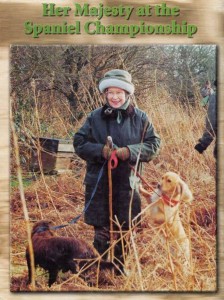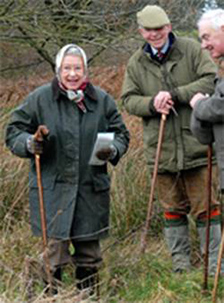Spaniels Training Tips for the Weekend Warrior
( published in Spaniels In The Field – winter 2003 )
My problem is a flyaway bird that is not shot and the dog must be called off the chase. She will not stop or give up the chase until she decided to. What steps can I take to correct this problem? She is a real soft dog and does not take harsh treatment at all, so a shock collar is out of the question. She is also a house pet that we both love very much.
Every spaniel is different in ability and working desire. Some spaniels need a lot of birds to chase and retrieve to develop these traits, others need very few birds to chase as these traits are strong and may even get them into trouble. This may or may not have any correlation with whether the dog is soft or hard in nature. I accept a short chase for an unsteady spaniel until it becomes a problem. Early on in the training process I teach the recall off missed birds for safety concerns. There is nothing that gets my heart beating quicker than a dog heading off towards a road or icy river chasing a bird in flight.
You will want to work the dog in a large/safe area where there are minimal concerns but easy for the dog to clearly see. I will usually use pigeons for this drill rather than game birds as they do not come down readily after a long flight. The last thing you want to happen is the dog finding birds to retrieve after you are trying to recall them back to you. You will need to have a couple of birds. One to make a very active clip wing the other for the dog to find, flush and chase. I usually will roll in the flyer giving me a close proximity to the dog. Allow the dog to find and give a short chase on the flyer of about 30 – 40 yards then while you still have a presence and proximity to the dog begin your recall whistle. Continue using the recall whistle until you have their attention. Once you have eye contact throw up the clip wing a short distance to you allowing them to complete the retrieve. I like using a clip wing to retrieve as most dogs find it more exciting to retrieve a clip wing than a dead bird. Performed a couple of times over a couple of training sessions it does not take long for them to figure things out.
When they listen to you they get a bird to retrieve, when they don’t listen they get nothing. Lots of praise with the correct response. If the dog is really not listening at all you may have to go and actually get them letting them know your disappointment in their performance. For some just a stern voice may do the trick. Others may need to be picked up eye to eye to get the idea. While you have their attention hit the recall whistle a couple of times to let them know what command they where blowing off. After you have control of the situation, have pup hup or sit in place while you walk away for a short distance of about 30 – 40 yards. Use the recall whistle and as the dog gets closer to you throw the clip wing up for retrieve as they where supposed to perform earlier. Lots of praise is due with the correct response. After they are coming in reliably well after a short chase you can drop the clip wing slightly ahead and to the outside in the opposite direction of the flying bird. When you bring the dog in off the missed bird cast them in the opposite direction for which they find yet another bird.
Again the reward is the bird and retrieve. This type of positive reinforcement helps develop consistency and confidence which is what we all want in a hunting or performance spaniel. On the comment of a “shock collar” not being an option in training due to the friendship and soft temperament. The new low intensity training collars are actually very well in tune with today’s soft temperament spaniels. Sometimes a “soft” dog gets rattled by a stern voice or by picking them up on correction. A properly used low intensity system can be nothing more than a tickle or very mild attention getter. The key is to knowing how to use them properly. Expect to get wet and dirty so dress appropriately. I usually wear my rubber boots and old clothes. It seems to make my wife happier! Try to go to water after a good workout in the field around mid day when the temperatures are warmer for introduction work. You should pick a place that is free of distractions such as people or other fowl. An easy entry point is especially important to begin with especially if pup is showing hesitation on water retrieves. Pick a flat spot where pup can go out some distance getting wet but not overwhelming. I like to take a pigeon and tape one wing to its body essentially making a clip wing that cannot go very far and usually can only propel in circles but makes a lot of exciting movement. Start by tossing it a couple of feet letting pup chase it immediately after release. Start short and work the distance as pup goes further and further with confidence. Two or three retrieves are plenty to begin with increasing the amount of retrieves over a couple of weeks as pup gains confidence. Then you can start intermittently using dead birds and dummies showing the same pleasure upon completion of retrieve. Keep it simple until pup is confident. I like to get right into the water with the youngsters as they are coming back with the retrieve. This avoids the temptation to drop at shoreline and shake as well as any avoidance of coming to hand. I adjust where I meet them to ensure they are coming right to me. Make a fuss over them, which they like and verbally tell them to shake after completion. This comes in handy as I moved further and further away from the water bank.
Avoidance of bad habits is easier than fixing them right? Sometimes when you switch to dummy work pup may lose the enthusiasm expressed with birds. Jealousy can be a great training tool for this. If you or a training/hunting partner have a reliable well-trained spaniel, let them get a couple of retrieves with pup watching. Often times pups get caught up in the moment and enthusiastically try to out perform the other dog. As with the clip pigeon, start short and work longer as pup gains confidence. If pup balks on the retrieve, send the other dog to complete the retrieve. If you have a question or a training topic you would like discussed please email, write or call us. We hold all correspondence in confidence. Keep those questions coming!
Good Training and Happy Hunting! –
JIM KELLER Jim Keller and his wife Denise own and operate Wildwind Kennels located in the heart of grouse and woodcock country in mid-coastal Maine. They work with all bird dog breeds specializing in flushing spaniels. Jim is a full time dog trainer with over 17 years of experience working with bird dogs for hunting and performance events. We campaign a limited group of spaniels in the US and Canada in Field Trials having made several field champions, and we actively participate in the Hunt Test program. Jim is also a registered Maine guide working for some of the finest sporting camps in Maine’s northwoods for grouse and woodcock. Jim can be reached at: Jim Keller – Wildwind Kennel 1368 Webb RD – Knox, Maine 04986 (207)831-1236 Kennel (207)568-3544 Home wildwind@uninets.net – www.uninets.net/~wildwind



